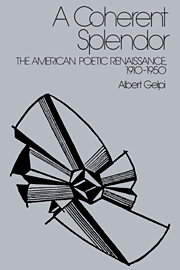Book contents
- Frontmatter
- Contents
- Acknowledgments
- Dedication
- Introduction. The Janus-Face of Romanticism and Modernism
- 1 Robert Frost and John Crowe Ransom: Diptych of Ironists, the Woodsman and the Chevalier
- 2 Wallace Stevens: World as Mundo, Mundo as World
- 3 T. S. Eliot: The Lady Between the Yew Trees
- 4 Ezra Pound: Between Kung and Elcusis
- 5 H. D.: Helen in Bethlehem, Hilda in Egypt
- 6 William Carlos Williams: Mother-Son and Paterson
- 7 Allen Tate and Hart Crane: Diptych with Angels and Demons
- Coda. Yvor Winters and Robinson Jeffers: The Janus-Face of Anti-Modernism
- Notes
- Index
7 - Allen Tate and Hart Crane: Diptych with Angels and Demons
Published online by Cambridge University Press: 22 January 2010
- Frontmatter
- Contents
- Acknowledgments
- Dedication
- Introduction. The Janus-Face of Romanticism and Modernism
- 1 Robert Frost and John Crowe Ransom: Diptych of Ironists, the Woodsman and the Chevalier
- 2 Wallace Stevens: World as Mundo, Mundo as World
- 3 T. S. Eliot: The Lady Between the Yew Trees
- 4 Ezra Pound: Between Kung and Elcusis
- 5 H. D.: Helen in Bethlehem, Hilda in Egypt
- 6 William Carlos Williams: Mother-Son and Paterson
- 7 Allen Tate and Hart Crane: Diptych with Angels and Demons
- Coda. Yvor Winters and Robinson Jeffers: The Janus-Face of Anti-Modernism
- Notes
- Index
Summary
John Crowe Ransom characterized his most brilliant student and lifelong friend in terms of coherence and consistency: “Allen Tate's mind is exceptional in its harmony.… His personality is as whole and undivided, and it is as steady, as it is vivid. Allen would readily have found his role in the Golden Age of Hellenism, or in classical Rome or the Elizabethan Renaissance.” Since Tate's poems and essays depict no Golden Age but a world of almost insupportable tension and anguish, Ransom's words may sound like an affectionate but deceptive extravagance. But although Tate's vision voiced the tormented divisions of the modern spirit, his angle of vision was steady, and from the outset his entire purpose was to find a basis for harmony. Tate's dilemma, like Eliot's, was precisely that of the would-be Christian classicist with the Romantic's psychological and spiritual problems.
As the first undergraduate invited to join the Vanderbilt professors who formed the Fugitive Group around Ransom, Tate was even then exceptional for the intellectual energy that restlessly pursued related lines of inquiry – literary, philosophic, social – to locate his psychological malaise in the larger cultural crisis. Already Tate aspired to be (in the title of an important essay of 1952) “The Man of Letters in the Modern World.” If he throve on his elders' company and attention, he also set about shaking them wide awake. Ransom remembered his earnestness and remembered too that praise from this relative youth was the most satisfying to the senior members of the group because it was the hardest earned.
- Type
- Chapter
- Information
- A Coherent SplendorThe American Poetic Renaissance, 1910–1950, pp. 373 - 422Publisher: Cambridge University PressPrint publication year: 1988



